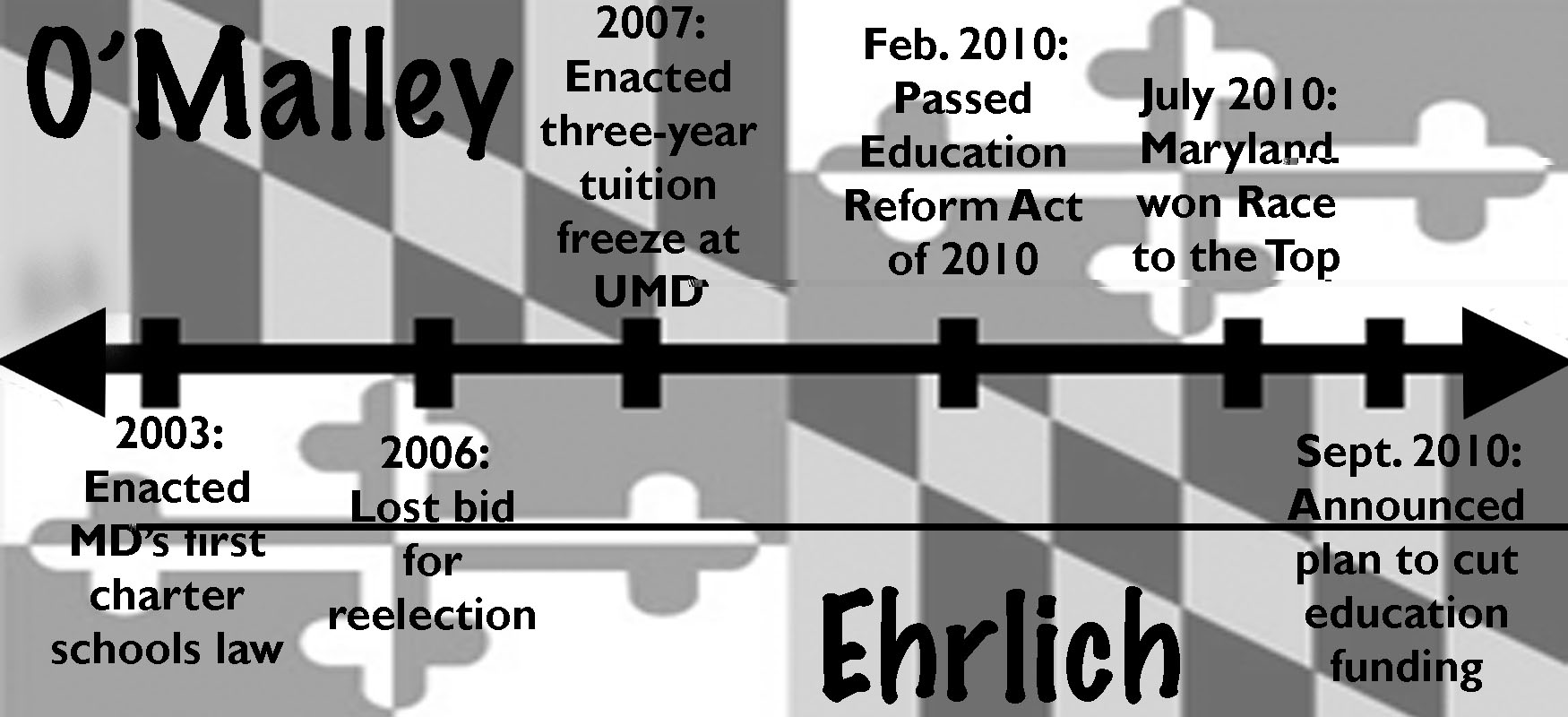Head of the class
In governor's race, divergent views on education
The best public school system in the nation, the number one education governor, $250 million in Race to the Top (RTTT) funds – it could all come crashing down on Nov. 2, if voters send a former tenant back to the governor's mansion. Or we could rid ourselves of overwrought standardization, dire neglect of teachers' union considerations and a complete failure to support charter schools. Which set of principles will vanish if Robert Ehrlich (R) reclaims Annapolis? It all depends on which side of the education debate's proverbial classroom you're sitting in.
Martin O'Malley, the Democratic incumbent, is running for a second term; Ehrlich, the one-term governor whom O'Malley ousted in a contentious 2006 battle, is out for electoral revenge in his third straight gubernatorial campaign. After trouncing insignificant opposition in their Sept. 14 primaries, both candidates are engaged in what appears to be an unusually close battle for such a Democratic state. Recent polls show O'Malley with only a single-digit lead, and Ehrlich's moderate conservatism in what looks to be a banner year for the GOP has kept the seat very much in play.For the lucky few Blazers who will be able to vote this year, that uncertainty presents a tantalizing opportunity to make an impact at the ballot box – and for those of us on the wrong side of 18, a surprising amount of policy that directly affects our educational lives is at stake.
O'Malley, who has touted education more broadly in his campaign than is usual for a governor in such a stagnant economy, has amassed an impressive list of accolades. From the number one schools ranking in the publication Education Week (well deserved) to the RTTT boost (less so, considering the competition), Maryland education has raised its profile considerably under the Democrat.
With an eye on RTTT, the Obama administration's competitive education grant initiative intended to motivate states to implement reform, Maryland enacted the Education Reform Act of 2010. The bill, which is O'Malley's principal educational legacy, was a landmark retooling of the state's system for teacher evaluation. It surged through the state legislature in the spring, but its changes, unfortunately, were something of a mixed bag. Extending the length of time before teachers can gain tenure and offering stronger incentives to those who work in the lowest-performing schools are promising improvements in accountability and closing the socioeconomic gap, respectively. But forcing student growth to determine 50 percent of teacher and principal evaluations is standardization hype run amok. It discounts simply too many intangibles to give educators a fair shake.
Expect to see the implementation of such changes become O'Malley's primary education priority if he remains in office. According to Bill Reinhard, a spokesperson for the Maryland State Department of Education, the bill culminates two decades and three major waves of education reform. "Now this is the next step, we think, and it's sort of the nexus of what we do," Reinhard said.
One of O'Malley's greatest achievements for Maryland students has already made an impact: a three-year tuition freeze for the University of Maryland system, which he imposed at the start of his tenure. It was a bold financial move and necessary relief amidst the bloated college fees market. His decision to lift the freeze and increase tuition and fees by 4.5 percent this year at the University of Maryland, College Park represents the right kind of tuition change: incremental. Ehrlich, in contrast, saw tuition at the same campus balloon by over 40 percent during his four years in office.
That administration, however, had one significant advantage over the current regime. Ehrlich's willingness to embrace public charter schools as an alternative method of educating students represented an innovative approach; when it comes to all those various gaps – racial, economic, geographical – that we're supposed to be narrowing, one classroom certainly doesn't fit all.
Those who vote GOP in November, though, will have to hope that Ehrlich doesn't look to the past when he begins to search for education funding sources: His tenure was marked by a severe problem of under-funding for even his best ideas for school reform. And though it's fair to attribute at least some of that failure to the budget deficit that he inherited, the man who presides over Annapolis come next January will face even worse shortfalls. We can't afford a governor who can't afford to fund our education initiatives properly.
Unfortunately, neither candidate has seriously looked outside the box for fresh ideas – increased student input in teacher evaluations hasn't even been on the table. In fact, given the broad spectrum of political ideas currently clamoring for attention across the country, O'Malley and Ehrlich don't sound all that dissimilar. That's why their education legacies and plans need closer scrutiny than ever. The devil here is in the details. If the latest polls are any indication, the margin of victory in this race will be just as minute.
Swing spot
Maryland statewide politics of the last couple decades have been dominated by the Baltimore metropolitan area – our governor and both senators are from the state's largest city. So it's nice to see that, according to a recent article in The Washington Post, Montgomery County is getting its due. The campaigns have signaled that there will be a major push to woo voters in northern county localities like Poolesville and Damascus. The county typically swings Democratic, but if Ehrlich takes more than 40 percent of the county vote, he may have a shot at winning.
Eli Okun. More »
Comments
No comments.
Please ensure that all comments are mature and responsible; they will go through moderation.
